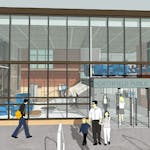The little town of Mendota — population 206 — seems an unlikely spot to boast a history of late-night jazz clubs. However, it has seen several, and the Emporium of Jazz became a long-running institution after it opened in 1966.
"It turned into a 25-year gig," said Charlie DeVore, who played cornet with the Hall Brothers Band, the house band for the Emporium.
The club opened five years after Preservation Hall in New Orleans, whose musicians started touring throughout the country. When they arrived in Mendota, it generated considerable press and attracted patrons from throughout the Twin Cities.
"The place was a smash," said Butch Thompson, a jazz clarinetist and pianist with the house band. "It was a real success."
The club drew New Orleans jazz artists like Kid Thomas Valentine and Sweet Emma Barrett and her band, as well as musicians from Chicago and both coasts. Hall Brothers musicians often sat in with the bands.
"I got to play with a lot of wonderful musicians who I wouldn't otherwise have had a chance to work with," said Thompson, who went on to lead the house band on "A Prairie Home Companion."
The "Funky Butt" dance floor, which looped around behind the band, was another draw.
"It was rigged so that the dancers could dance but they wouldn't obstruct the view for people who wanted to just sit at tables and listen," said Thompson.
Dancers could boogie behind the bandstand and wouldn't feel self-conscious, "and that was very popular," said DeVore.
Post-gig jam sessions
Jazz in Mendota dates back to the 1930s, said DeVore, when there was a short-lived club called Mitch's. Big-name acts that played clubs and theaters in the Cities would flock there after shows and play until 3 or 4 a.m.
"When the bands would come through," DeVore said, "they would be looking for a place to jam afterwards."
DeVore became immersed in New Orleans jazz when he was stationed there with the Navy from 1954 to 1957.
"That was the watershed event of my life," he said.
There, he met jazz historian William Russell, who owned a record store in the French Quarter. Russell introduced DeVore to local musicians, and he got to see players like George Lewis, a jazz clarinetist, whose recordings he had listened to as a teenager. Forgoing the more commercial bands on Bourbon Street, DeVore frequented Saturday shows by Kid Thomas Valentine at an Algiers club.
"I don't think I missed a Saturday night," he said.
The Hall Brothers
DeVore had started playing cornet in New Orleans, and after returning to Minnesota, he met Stan and Russ Hall at Dixieland Record Heaven. They practiced in their basement, and soon the Hall Brothers Jazz Band had set up a makeshift bandstand — hoisting a piano onto a paint shop door perched on paint drums — outside Brady's Garage near the University of Minnesota. The monthly shows went from about 8 p.m. to 5 a.m.
"James Brady knew the policemen on the beat," said DeVore, "so he could convince them to look the other way."
During this time, Dixieland jazz player Doc Evans turned a former Mendota neighborhood bar called the Bow and Arrow into the Rampart Street Club, named after a street in New Orleans. The Hall Brothers sometimes filled in when his band traveled.
"Much to the chagrin of people that would travel to hear the great Doc Evans," DeVore said, "it would be these young kids."
Butch Thompson joined the band in 1962 as an 18-year-old college student. He had been listening to DeVore's records, and a trip that year to Preservation Hall "kind of did it for me," he said. "The music that night, I hadn't heard anything like it. That knocked me out."
The group eventually gigged regularly at local clubs and bars, and a dentist named Dave Odell helped open the Emporium of Jazz in 1966. "He was the angel behind the club," said DeVore. "It was wonderful because it was our own place."
One of the highlights of the club was the annual July festival inspired by the street brass band tradition of New Orleans. Musicians visiting Mendota would parade down the main street on a Saturday afternoon and others would "second line," or follow along dancing.
The parade went through the tiny main street and into a residential area and looped around again. "We would do it about three times," said DeVore. "People thought, 'Gosh, boy, this is a really long parade.'… We had some wonderful times."
In 1991, the Emporium of Jazz closed its doors and was turned into a sports bar.
"There were fewer and fewer of the old-time New Orleans musicians available," said Thompson. "Just attrition naturally. It just started to slow down. It ran its course."
Liz Rolfsmeier is a Twin Cities-based freelance writer. Her e-mail is lizannrolfsmeier@gmail.com.




